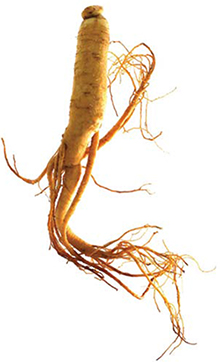
Ginseng encompasses several species of plants of the genus Panax with forked roots and small greenish flowers grouped in umbels. The major varieties of ginseng include Asian (Panax ginseng) and American (Panax quinquefolius). Another major variety, Siberian ginseng (Eleutherococcus senticosus), is in the same family as the first two but of a different genus. The word ginseng comes from the Mandarin renshen: ren, meaning “person,” and shen, meaning “root”—most likely due to the forked root shape’s resemblance to human legs.
Ginseng has been used in China for 5,000 years. Because Chinese emperors treasured the plant, it became highly valued and in demand. The Native Americans are responsible for ginseng’s cultivation in North America. The Cherokee, Iroquois, and other tribes used ginseng as a remedy for various ailments and for general life enhancement.

Healing Uses: Ginseng is considered a panacea—a cure-all. It is an adaptogen, a natural substance that helps the body adapt to stress, and it also lowers blood sugar levels. Ginseng is associated with stimulation and virility and is a common remedy for impotence. Those taking heart medications such as blood thinners should not take ginseng, as it could result in a negative interaction.
Magical Uses: Ginseng is a powerful love herb. It generates passion and lust, especially when drunk as a tea. Burn ginseng root or powder as incense to repel negativity, drive away evil, and break hexes or curses. Carry ginseng root with you to attract love or money. As an amulet, it brings good fortune, prosperity, longevity, and fertility.
Personal/Spiritual Growth: Ginseng boosts both mental and physical energy levels, which can then be used to harness internal power. It reduces psychological stress and sharpens mental powers. Ginseng also aids in visualization fulfillment. Take ginseng before meditation for enhanced clarity and a sense of calm.